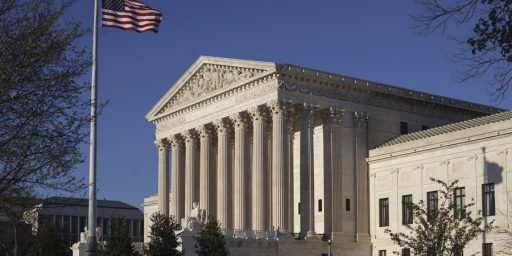Supreme Court Upholds Michigan Referendum Banning Affirmative Action In Higher Education
The Supreme Court may have just found a way to end the debate over Affirmative Action in education.
Last October, the Supreme Court heard oral argument in a case challenging a referendum that Michigan voters had overwhelmingly passed in 2006 which banned race based preferences at the state’s public universities. To a large degree the referendum was a response to the Supreme Court’s 2003 decision in Grutter v. Bollinger, which had largely upheld the race based admissions polices of the University of Michigan’s Law School. Almost immediately, various civil rights organizations filed suit contending that the law was unconstitutional and, in 2012, the Sixth Circuit Court of Appeals agreed with them in an opinion that quite literally divided the full court, finding that the referendum violated the Equal Protection Clause because of the manner in which it changed state law to make it harder for minorities to effect political change. As I noted at the time that the case was argued, these arguments seemed to be incredibly weak, at least as argued before the Court, and I predicted that the Court would up hold the referendum.
Today, in a decision that was as divided as cases dealing with Affirmative Action have always been since the days of Regents of the University of California v. Bakke, the Supreme Court upheld the referendum, although it’s unclear what impact the ruling will have on any future cases dealing with racial preferences in education and hiring:
WASHINGTON — The Supreme Court on Tuesday upheld a Michigan voter initiative that banned racial preferences in admissions to the state’s public universities.
“This case is not about how the debate about racial preferences should be resolved,” Justice Anthony M. Kennedy wrote in a controlling opinion joined by Chief Justice John G. Roberts Jr., and Justice Samuel A. Alito Jr. “It is about who may resolve it. There is no authority in the Constitution of the United States or in this court’s precedents for the judiciary to set aside Michigan laws that commit this policy determination to the voters.”
Justice Sonia Sotomayor read an impassioned dissent from the bench. She said the initiative put minorities to a burden not faced by other applicants to college.
“The Constitution does not protect racial minorities from political defeat,” she wrote. “But neither does it give the majority free rein to erect selective barriers against racial minorities.” Justice Ruth Bader Ginsburg joined the dissent.
In earlier cases, including one from June concerning the University of Texas, the court has said that race-conscious admissions policies can be constitutionally permissible in states that wish to use them. The new decision concerned the question of whether and how voters may prohibit affirmative action programs.
Lyle Denniston analyzes the opinion, and notes that the Supreme Court has essentially decided that the fate of affirmative action programs is up to the voters as much as it up to the courts:
The decision in Schuette v. Coalition to Defend Affirmative Action upheld Michigan’s Proposal 2, approved by the state’s voters in 2006 by a margin of fifty-eight to forty-two percent. The measure told the state’s public colleges and universities that they could no longer “grant preferential treatment” on the basis of race in their admissions policies.
Justice Anthony M. Kennedy, in the opinion that controlled the outcome, insisted that the Court was saying nothing new on the constitutionality of public policies that take race into account. “This case,” he wrote, “is not about how the debate about racial preferences should be resolved. It is about who may resolve it….The holding in the instant case is simply that the courts may not disempower the voters from choosing which path to follow.”
He added: “There is no authority in the Constitution of the United States or in this Court’s precedents for the Judiciary to set aside Michigan laws that commit this policy determination to the voters.”
A federal appeals court, the U.S. Court of Appeals for the Sixth Circuit, had struck down Michigan’s ballot measure, relying primarily upon the concept that it is unconstitutional for voters to change the way public policies are developed to make it more difficult to adopt or keep policies that protect racial minorities from discrimination.
That approach, known as the “political process theory,” is traced mainly to a 1982 Supreme Court ruling, Washington v. Seattle School District – a decision that overturned a Washington ballot measure barring the use of busing to achieve racial desegregation in the city’s public schools.
On Wednesday, the Court majority flatly rejected that theory, implicitly overruling that part of the 1982 ruling. The theory, Justice Kennedy wrote, was not essential to the result in that case, and was itself a form of encouraging an unhealthy tendency to group minority individuals together as if they commonly shared the same views on public policy.
“It cannot be entertained as a serious proposition,” the opinion said, “that all individuals of the same race think alike.” But, it said, that assumption would have to be the “beginning point” if a court were required to analyze what government policies racial minorities believe to be in their interest.
Pursuing such an inquiry, Kennedy said, would “impose a high risk of inquiries and categories dependent upon demeaning stereotypes, classifications of questionable constitutionality on their own terms.” Moreover, he said, courts would have to determine “the policy realms in which groups — groups defined by race — have a political interest.”
That process would lead to “racial antagonisms and conflict,” according to the Kennedy analysis.
By contrast, the lead opinion said, voters can be trusted to decide the racial preferences issue at the polls. “Our constitutional system embraces…the right of citizens to debate so they can learn and decide and then, through the political process, act in concert to try to shape the course of their own times and the course of a nation that must strive always to make freedom ever greater and more secure.”
The race issue, Kennedy said, is not so sensitive that it cannot be made the topic of political conversation and submitted to a referendum of the voters.
The Kennedy opinion was supported in all of its reasoning only by Chief Justice John G. Roberts, Jr., and Justice Samuel A. Alito, Jr. But it will serve as the controlling opinion because its result — upholding Proposal 2 — was supported also by Justices Antonin Scalia and Clarence Thomas.
Thomas and Scalia argued in their concurrence that the Court should have ruled that all race-based admissions policies are unconstitutional. This is a position that they have both taken in previous affirmative action cases before the Court, including the University of Texas case that the Court handed down last June. However, as Justice Kennedy made clear in his opinion, it wasn’t necessary for the Court to reach that issue in order to rule on the constitutionality of Proposal 2. All that they Court needed to determine was whether or not it was permissible for a majority of Michigan voters to decide that it would no longer be permissible for state-run colleges and universities to give preferential consideration to students based on race on the theory that this was somehow necessary because of past discrimination. The Court determined, as noted, that there was no equal protection violation here.
Notwithstanding the arguments of the opponents of the referendum and the dissent, it strikes me that the the Court reached the correct decision here. While there are certainly limits on how a majority can use the political process when it comes to the rights of the minority, the Equal Protection Clause has never stood for the proposition that the democratic process can be overridden by courts in every case where minority “rights” might be impacted. Furthermore, the Supreme Court has explicitly never held that there is such a thing as a “right” to race-based preferences except in instances where there has been direct evidence of discriminatory action taken against specific individuals. That wasn’t the case in Michigan, nor was it the case in Texas. Indeed, it’s unlikely that such discrimination would take place in today’s environment to begin with. Additionally, even if one could agree that Affirmative Action was a good idea at some point, there’s no rational reason why it should be permitted to continue indefinitely. The voters strike me as a being just as able to determine when that point has been reached as unelected judges or educational administrators with political agendas that may not be in the best interests of the voters they are supposed to be worked for.
While this case is not likely to have any impact on future Affirmative Action litigation, it’s not hard to see where the debate over race-based preferences goes from here. The Supreme Court has given open space for other states to enact legislation similar to Proposal 2, and it’s not going to take very long for states to walk through that door. States that are controlled by Republican legislatures and Governors will likely be the first to act, of course, but we’ll also probably see moves for referendums in other states where getting such a measure through the legislature would not be so easy. The Supreme Court has been reluctant to deal with Affirmative Action in education ever since Bakke was handed down in 1979, by handing this victory to Michigan they very well may have set in motion a process that will largely resolve the issue without them having to act.
Here’s the opinion:
Schuette v. Coalition to Defend Affirmative Action by Doug Mataconis







Republican wishing away racism. So precocious.
Except for the fact that in our country, voters have often had political agendas that involved denying equal protection under the law to various citizens – except for that – I would probably agree with you concerning the voters.
@Doug Mataconis
Quoting the American Voter on their racial enlightenment isn’t exactly a winning proposition in terms of American history. They eventually supported stuff like the Civil Rights Act, but that was after aggressive action from below by Civil Rights activism, and pressure from above coming from the Supreme Court.
The need for affirmative action will end when black households have the same income/wealth/education spread as white households, and when women have an equal presence in education, the business elite, and the political elite. Until then, it should continue.
And the good news is that if those uppity minorities do manage to organize to put affirmative remedies to discrimination on the ballot, this same court has ruled that it’s not discriminatory for a state to do everything they can to prevent them from voting — but it is unconstitutional to keep billionaires from spending as much as they want to ensure the outcome they want at the polls.
To a libertarian, this is called equality.
@Brett:
Of I guess the progressives response is affirmative action today, affirmative action tomorrow, affirmative action forever. What is amazing is that 60 years after Brown v Board of Education that progressives are arguing for separate and unequal treatment on the basis of race/ethnicity/gender is not only legal but good public policy.
I guess people have already forgotten the Gratz v Bollinger decision where the State of Michigan was caught red handed using separate and unequal admission standards for black and Latinos versus whites and Asians for undergraduates at the University of Michigan. When the State of Michigan responded to their lost in front of the Supreme Court by promising to keep using separate and unequal standards but would just not put the standards in writing what else were the voters of the state suppose to do?
How many times are progressives going to argue that the cure for past discrimination is future discrimination.
I think it’s important to bear in mind that this decision was 6-2., Sotomayor and Ginsburg dissenting. That suggests that to the extent that ideology played a part in the decision it was on the part of the dissent.
For supporters of affirmative action the task is now to persuade rather than depending on the Court to impose it.
@Dave Schuler:
If would be interesting to hear the supporters of affirmative action to make the argument that the University of Michigan at Dearborn was good enough for Jennifer Gratz but was not good enough for black students who had lower SAT scores and GPAs. As long as most Americans act from the POV that the dumbest student at the University of Michigan is smarter than the smartest students are all of the second tier universities in Michigan, then there is no room for affirmative action in America.
I think TBogg nails Roberts here:
An alternative version is that Roberts is just a very smooth talking, polite plutocrat and racist. Hard to imagine someone as smart as him being THAT naïve.
@Dave Schuler:
“Persuade?” What the Roberts court is telling everybody is “Forget trying to make up for 400 years of slavery , 100 years of Jim Crow, and continuing discrimination to this day. You’re off the hook, guys! In fact , you can go back to treating blacks any way you want, and it’s not racism, because we’ve declared that racism is over!”
What’s next? Resuscitating Plessy vs Ferguson? The Court told Plessy at that time that his being relegated to a “blacks only ” section wasn’t bigotry, either.
I oppose Affirmative Action, not because I think that racial discrimination is a thing of the past — I don’t — but because it doesn’t work, and it isn’t helping to solve the problem. Which is real, and urgent.
At least one prominent African-American agrees with me.
@stonetools:
Uh, no. It said that the voters of the state of Michigan have the power to ban discrimination on the basis of race.
Doug? You have said a lot of numb skull things over the years, but this one takes the cake. The SC can’t even find a way to end the debate over their own decisions.
@DrDaveT:
Two if you include Clarence Thomas
@DrDaveT:
I have read Mr. MacWhorter, and while he is against certain kinds of AA, he certainly isn’t against all AA.(He wants it based on class, not race). He certainly isn’t saying what the Roberts Court seems to be saying, which is that racism is over and we no longer need to guard against racial discrimination.
The reality is of course is that these states aren’t going to now switch to doing the right things to help blacks and other minorities. Instead, they are just going to do NOTHING. Mission accomplished, guys.
Of course, children of rich people are still going to get into those colleges (so called legacy admissions). THAT kind of affirmative action , oddly enough, is just fine with affirmative action opponents and was specifically protected by the constitutional provision in question and by the Supreme Court.
I understand the emotions of Michigan voters in banning affirmative action at UM, but when I’m on campus I’m disturbed by the small number of black and Hispanic students. Michigan is a state with a bad history of race relations, and I’m pretty sure that the university leadership instituted its affirmative action program in an attempt to integrate minorities into the general society and to help white students and faculty feel more comfortable with African-Americans. Based on my personal experience as a professor in the Michigan engineering college, I can’t say that I noticed any marked difference in ability between the white and African-American students in my classes. The performance of the African-American students upset some of my own preconceived notions about racial differences in the US, and I hope it did the same for white students and faculty in general.
I’m afraid of the development of a two-tier society in the US, and I think the Supreme Court’s decision is a big step in the wrong direction. At every stage of education, from kindergarten to graduate school, we spend more money on the education of well off white kids, like mine, than on the poor of both races. I think this is a horrible mistake.
@Stan:
The University of Michigan has been prevented from using separate and unequal criteria for the last 10 years or more. Beofre that, If I remember correctly, the University of Michigan may have been admitting black and Hispanics using a lower standard but I believe that the separate colleges and programs had their own admission criteria. At least I remember reading about it in MItch Alboms boo on the Fab Five. I doubt if the engineering program has admitting blacks whose math SAT scores were several 100 points below the average SAT scores of white and Asian students.
Also, how many of those black engineering students were immigrants or the children of immigrants? It is hard to argue that affirmative action is meant to off set 400 years of discrimination when so many immigrants were taking advantage of it.
@stonetools: I should have been more clear — I didn’t mean to imply that McWhorter (or I) would agree with the Roberts court. Their argument is crap, but it doesn’t piss me off because I want to end race-based AA. Frankly, as I understand the terms, if it’s class-based (which makes every kind of sense) it isn’t Affirmative Action. AA is all about historical disadvantage, not current status. And while the historical disadvantage of black Americans persists to this day, I agree with Dr. McWhorter that AA isn’t going to change that in any useful way.
@superdestroyer: I don’t have statistics, but I can tell an African-American accent from an African accent. I can’t recall having taught any Africans in my undergraduate classes. The Africans I knew in the College were graduate students and other professors.
With regard to your general argument, the Michigan affirmative action program wasn’t rigid. Students got points based on various factors when it came to admissions. As one might expect, the largest number of points were based on high school grades, SAT and ACT scores, and extracurricular activities. I think my kids each got an extra point toward admission because they attended a good high school, one with known high standards. They may also have gotten a point because my wife and fifteen to twenty of her relatives had Michigan degrees. The points not based on individual achievement or family connections were a) racial, with extra points given to African-American and and other minority students, b) geographical, with a few extra points given to applicants from northern Michigan, a poor region now ravaged by crystal meth, and c) athletic ability. To my best knowledge, b) and c) are still in existence. So if you know a really good high school fullback from the Upper Peninsula, tell him to apply to the Ann Arbor campus. If he’s admitted despite having a C- high school average, nobody will object.
@Stan:
If you look at
http://www.vpcomm.umich.edu/admissions/archivedocs/q&a.html
you will see that being black or Latino was worth 20 points while having a 1600 on the SAT exam was worth 12 points or being a legacy was worth a couple of points. There was a definite separate and unequal standard for black and Latino students versus white suburban students and that being black was the most significant for being admitted. The elimination of affirmative action lower the percentage of blacks at the University of Michigan
http://www.nytimes.com/interactive/2013/06/24/us/affirmative-action-bans.html
from around 10% to around 5%. I doubt if it really affected the number of blacks in the engineering program since that 5% of students who were black would be the type who could actually gain admission to the College of Engineering.
Also, the college of engineering had higher standards for admission versus school of kineseology or school of social work. The University of Michigan was very careful to make sure that affirmative action did not lower the quality of most of its academic programs nor lower its graduation rates very much. Even after the elimination of affirmative action, graduation rates for blacks are still lower than for white and Asian students http://collegeresults.org/search1a.aspx?institutionid=170976
here’s an idea, why do we need to check a box that says we’re any ethnicity? just remove them from any application, that should take care of the “racist” schools and employers.
aa didn’t work anyway, as “enabling” rarely does.
@superdestroyer: You’re misrepresenting the point system used in the Michigan admissions program under discussion. The document you cited states that Michigan used 150 total admission points. 80 points were based on GPA, 12 on SAT or ACT, 10 on having attended a high school with good academic standards, and 8 on having taken an academically rigorous program. We’re now up to 110 points out of 150. 20 points were given for being a minority or being economically disadvantaged, and 16 for being from the Upper Peninsula, the area of the state immediately south of Lake Superior. These standards helped minority students gain admission, but they were far from being decisive. Ceteris paribus, a poor white kid from the UP was helped more by the admissions standards than a middle class black kid from Detroit. So I can’t accept your argument.
Back in 03, this case was bubbling up, and I commented on it back then. My comments at that time still apply. Mind, Bollinger and Bakke both appear to have been overturned by this more recent ruling, and than God for that. they got this one right, and on the same reasoning I objected to Bollenger.
I should, perhaps note, that my read of this ruling doesnt prohibit using race as a criteria, it simply allows states to make their own choices. That’s worth celebrating because as Ive pointed up in previous discussions, Im sure that given the choice, the states will choose correctly, as Michigan has. and I wonder if all the howling we hear from the left, which would obviously include Sotomayor, can be taken as indication that they think so, as well.
It is interesting how few lawsuits are filed by white applicants who have complaints that preferences unrelated to academic and test score performance were given to white applicants with lower grades and test scores.
It always seems that white students were not admitted because lesser qualified non-whites were admitted ahead of them. Statistically, that is amazing, given the number of white students that are admitted to public universities every year. Evidently, white students denied admission have been so only because of the admission of non-white students with fewer qualifications.
@al-Ameda:
There is no constitutional amend that says that a public university cannot give preferences to legacies. However, there is an amendment that requires due process by the government when it comes to race. What is amazing is many people on the left keep forgetting that the government cannot discriminate on the basis of race. And there is a huge amount of case law on what governments cannot due when it comes race-based discrimination.
@superdestroyer:
Exactly, it is common for institutions to use discriminatory criteria all the time. It’s just that when you’re talking about redressing the effects of 200 years of slavery and apartheid, it makes absolutely no sense to consider race in remedies – I get it.
@al-Ameda:
Since the U.S. does not allow group guilt or group punishment, then any attempt to “redress the effects” of slavary is pointless. Even the State of Michigan did not claim that its affirmative actin programs were meant to redress previous discrimination since the State of Michigan did not have a history of discriminating against blacks (or Latinos). The State of Michigan just claimed that white students needed a certain percentage of the student body to be black (or Latino) to improve their education (See the Gratz, Grutter, Hopwood, and Fisher court cases).
IN addition, how does giving Latino students exactly the same boost help redress the effects of slavary? How does giving recent immigrants or the children of recent immigrants help reduce the effects of slavary. How does giving mixed raced children help redress the effects of slavary?
If affirmative action was actually designed to help redress the effects of slavary it would be a very different program. However, if affirmative action was meant to be a special benefit to a core groups of one political party, it would look pretty much what it looks like today.